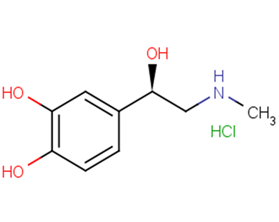
Epinephrine HCl
CAS No. 55-31-2
Epinephrine HCl( Epinephrine hydrochloride | l-Adrenaline chloride )
Catalog No. M18798 CAS No. 55-31-2
Epinephrine HCl is a hormone and a neurotransmitter.
Purity : >98% (HPLC)
 COA
COA
 Datasheet
Datasheet
 HNMR
HNMR
 HPLC
HPLC
 MSDS
MSDS
 Handing Instructions
Handing Instructions
| Size | Price / USD | Stock | Quantity |
| 25MG | 49 | In Stock |


|
| 50MG | 72 | In Stock |


|
| 100MG | Get Quote | In Stock |


|
| 200MG | Get Quote | In Stock |


|
| 500MG | Get Quote | In Stock |


|
| 1G | Get Quote | In Stock |


|
Biological Information
-
Product NameEpinephrine HCl
-
NoteResearch use only, not for human use.
-
Brief DescriptionEpinephrine HCl is a hormone and a neurotransmitter.
-
DescriptionEpinephrine HCl is a hormone, neurotransmitter, and medication. Epinephrine is normally produced by both the adrenal glands and certain neurons. It plays an important role in the fight-or-flight response by increasing blood flow to muscles, output of the heart, pupil dilation, and blood sugar. It does this by binding to alpha and beta receptors. It is found in many animals and some single cell organisms.
-
In Vitro——
-
In Vivo——
-
SynonymsEpinephrine hydrochloride | l-Adrenaline chloride
-
PathwayMAPK/ERK Signaling
-
TargetERK
-
RecptorAdrenergic Receptor
-
Research AreaOthers-Field
-
Indication——
Chemical Information
-
CAS Number55-31-2
-
Formula Weight219.67
-
Molecular FormulaC9H13NO3·HCl
-
Purity>98% (HPLC)
-
Solubility——
-
SMILESCl.CNC[C@H](O)C1=CC=C(O)C(O)=C1
-
Chemical Name4-(1-hydroxy-2-(methylamino)ethyl)benzene-1,2-diol hydrochloride
Shipping & Storage Information
-
Storage(-20℃)
-
ShippingWith Ice Pack
-
Stability≥ 2 years
Reference
1. Berecek KH, et al. Am J Physiol, 1982, 242(4), H593-601.
molnova catalog



related products
-
Officinalisinin I
Officinalisinin I can effectively reduce the blood glucose and protect nerve injuryin diabetic mice.
-
NVP 231
NVP-231 is a potent, specific, and reversible CerK inhibitor(IC50=12±2 nM) that competitively inhibits binding of ceramide to CerK.
-
NMDA
N-Methyl-D-aspartic acid is an amino acid that, as the D-isomer, is the defining agonist for the NMDA receptor subtype of glutamate receptors.



 Cart
Cart
 sales@molnova.com
sales@molnova.com


